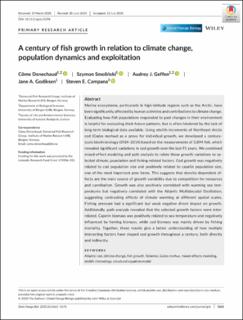| dc.description.abstract | Marine ecosystems, particularly in high‐latitude regions such as the Arctic, have been significantly affected by human activities and contributions to climate change. Evaluating how fish populations responded to past changes in their environment is helpful for evaluating their future patterns, but is often hindered by the lack of long‐term biological data available. Using otolith increments of Northeast Arctic cod (Gadus morhua) as a proxy for individual growth, we developed a century‐scale biochronology (1924–2014) based on the measurements of 3,894 fish, which revealed significant variations in cod growth over the last 91 years. We combined mixed‐effect modeling and path analysis to relate these growth variations to selected climate, population and fishing‐related factors. Cod growth was negatively related to cod population size and positively related to capelin population size, one of the most important prey items. This suggests that density‐dependent effects are the main source of growth variability due to competition for resources and cannibalism. Growth was also positively correlated with warming sea temperatures but negatively correlated with the Atlantic Multidecadal Oscillation, suggesting contrasting effects of climate warming at different spatial scales. Fishing pressure had a significant but weak negative direct impact on growth. Additionally, path analysis revealed that the selected growth factors were interrelated. Capelin biomass was positively related to sea temperature and negatively influenced by herring biomass, while cod biomass was mainly driven by fishing mortality. Together, these results give a better understanding of how multiple interacting factors have shaped cod growth throughout a century, both directly and indirectly. | en_US |
